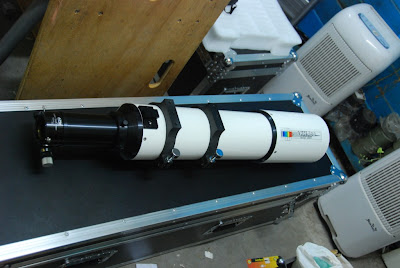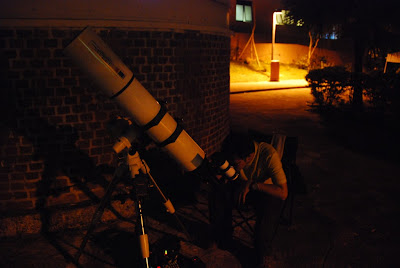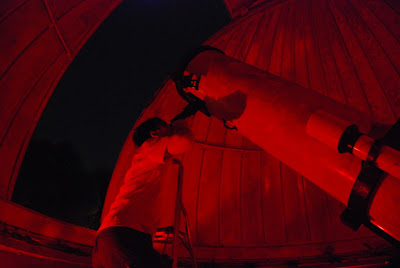Last night I was in Tai Po. The main task was APO testing. The dealer imported a few APM/TMB APOs. It was a rare chance that one could have a side by side comparison of 100mm/F800mm, 130mm/F1200mm and 203mm/F1420mm APOs. The 203mm/F1420mm was owned by the dealer. The other two APOs were goods. However, it was ruined by the bad sky condition! The sky was very hazy. The seeing was very bad. The moon was covered by a yellowish Arabian mask. It would be nice if you are not stargazer. When I back home, I browsed around the Internet. It seemed that all local observation sites, like Pak Tam Chung, were disappointing. I got ready the equipment in my boot in the afternoon. It would be meaningful to know how good those APM APOs compared with Equinox. Finally I decided not to setup my equipment and just tried those APOs.
At a first glance, the tube material was robust lightweight polymer. Both 100mm/F800mm and 130mm/F1200mm can be mounted on EQ3Pro. I forgot to carry both APOs and got a feeling of how heavy they were, but they should not belong to heavy class. Everything was strongly and nicely built. The base and the bracket of the finder scope were quite unique. I would not say it is stylish, but the design concept was neither Japanese nor Chinese, but German. The Feather Touch focuser was solid. Well back to the main dish, optical performance. Both APOs delivered high contrast images. I tried another 12” Newtonian last night. The Newtonian deliver brighter images, but it contrast was far below than that of APOs at similar magnifications. We boosted the magnifications to 288X and ~500X for 100mm/F800mm and 130mm/F1200mm respectively. These mean we pushed the limit to 72X/inch (288X) and 96X/inch (500X) respectively. The 100mm/F800mm was able to handle 72X/inch. Although the Jupiter image was breakdown under 96X/inch for the 130mm/F1200mm, one could still see some color fringes of Jupiter. That was not a flat images disc of Jupiter.
Last night there were two points I especially want to mention, the chromatic aberration and the resolution of the surfaces the Jupiter’s satellites. When I used the APOs to observe the Jupiter, the north pole of the Jupiter was a bit bluish. The dealer said it was due to atmospheric chromatic aberration, not the chromatic aberration of the APO. Here comes the question! Is the dealer telling the truth? To me, this is a physics question. If the optics got no or low astigmatism, the chromatic aberration should be cylindrical symmetric. There should be false color around the star, not just appearance in certain direction. My conclusion is that the bluish color at the north pole of Jupiter was caused by atmospheric aberration. One can do some experiments to verify this. Use the same telescope to observe the same object and see if the position of the aberration changes with time. About the resolution of the surface of the Jupiter’s satellites, moon surface, we saw all four satellites, IO, Europa, Callisto and Ganymede. The dealer and I were not sure about the moon surfaces were revealed or they were just Airy discs. As the magnitude of those satellites were small, probably larger than 5. When I observed the satellites by the 100mm/F800mm APO, it seemed that I saw the 1st order diffraction ring, but I was not sure. But it was possible that it was Airy disc. When we used the 130mm/F1200mm APO, the image of the satellite improved a bit. The hazy sky kept on discourages us whole night. It seemed that the 130mm/F1200mm APO gave a more solid image. However, it was illusion or fact. We need to wait for the sky. But it is highly possible that these two APOs will be delivered to new owners. So what can I do! Ha! Ha! Use theory to justify it! As these two APOs were claimed to be diffraction limited, we can do some calculations and see if it is possible to see the moon surface.
The visual angles in arc second of the satellites are:
IO 1.2”
Europa 1”
Callisto 1.6”
Ganymede 1.7”
By using the Rayleigh Criteria, we can calculate the theoretical limit of the resolution of the telescope.
R = 1.2 L/D where R is the resolution, L is the wavelength and D is the diameter.
The resolution calculated is in radian, we can convert it back to degree easily. In order to get a feeling of how good is the optics, I assume the average wavelength of visible light to be 550nm. After some simple calculations, for diffraction limited optics, the resolution of different diameter in arc second is given below:
100mm 1.36”
130mm 1.05”
203mm 0.67”
It means that 100mm APO is not able to resolve the Jupiter’s moon surface. The image was just an Airy disc. The 130mm APO can barely resolve the Jupiter’s moon surface. The 203mm APO can resolve Jupiter’s moon surface. This is a simple discussion, meaning that if the optics is diffraction limited, it is possible to resolve it. On the other hands, the practical optic is not possible to go beyond the theoretical limit.
At a first glance, the tube material was robust lightweight polymer. Both 100mm/F800mm and 130mm/F1200mm can be mounted on EQ3Pro. I forgot to carry both APOs and got a feeling of how heavy they were, but they should not belong to heavy class. Everything was strongly and nicely built. The base and the bracket of the finder scope were quite unique. I would not say it is stylish, but the design concept was neither Japanese nor Chinese, but German. The Feather Touch focuser was solid. Well back to the main dish, optical performance. Both APOs delivered high contrast images. I tried another 12” Newtonian last night. The Newtonian deliver brighter images, but it contrast was far below than that of APOs at similar magnifications. We boosted the magnifications to 288X and ~500X for 100mm/F800mm and 130mm/F1200mm respectively. These mean we pushed the limit to 72X/inch (288X) and 96X/inch (500X) respectively. The 100mm/F800mm was able to handle 72X/inch. Although the Jupiter image was breakdown under 96X/inch for the 130mm/F1200mm, one could still see some color fringes of Jupiter. That was not a flat images disc of Jupiter.
Last night there were two points I especially want to mention, the chromatic aberration and the resolution of the surfaces the Jupiter’s satellites. When I used the APOs to observe the Jupiter, the north pole of the Jupiter was a bit bluish. The dealer said it was due to atmospheric chromatic aberration, not the chromatic aberration of the APO. Here comes the question! Is the dealer telling the truth? To me, this is a physics question. If the optics got no or low astigmatism, the chromatic aberration should be cylindrical symmetric. There should be false color around the star, not just appearance in certain direction. My conclusion is that the bluish color at the north pole of Jupiter was caused by atmospheric aberration. One can do some experiments to verify this. Use the same telescope to observe the same object and see if the position of the aberration changes with time. About the resolution of the surface of the Jupiter’s satellites, moon surface, we saw all four satellites, IO, Europa, Callisto and Ganymede. The dealer and I were not sure about the moon surfaces were revealed or they were just Airy discs. As the magnitude of those satellites were small, probably larger than 5. When I observed the satellites by the 100mm/F800mm APO, it seemed that I saw the 1st order diffraction ring, but I was not sure. But it was possible that it was Airy disc. When we used the 130mm/F1200mm APO, the image of the satellite improved a bit. The hazy sky kept on discourages us whole night. It seemed that the 130mm/F1200mm APO gave a more solid image. However, it was illusion or fact. We need to wait for the sky. But it is highly possible that these two APOs will be delivered to new owners. So what can I do! Ha! Ha! Use theory to justify it! As these two APOs were claimed to be diffraction limited, we can do some calculations and see if it is possible to see the moon surface.
The visual angles in arc second of the satellites are:
IO 1.2”
Europa 1”
Callisto 1.6”
Ganymede 1.7”
By using the Rayleigh Criteria, we can calculate the theoretical limit of the resolution of the telescope.
R = 1.2 L/D where R is the resolution, L is the wavelength and D is the diameter.
The resolution calculated is in radian, we can convert it back to degree easily. In order to get a feeling of how good is the optics, I assume the average wavelength of visible light to be 550nm. After some simple calculations, for diffraction limited optics, the resolution of different diameter in arc second is given below:
100mm 1.36”
130mm 1.05”
203mm 0.67”
It means that 100mm APO is not able to resolve the Jupiter’s moon surface. The image was just an Airy disc. The 130mm APO can barely resolve the Jupiter’s moon surface. The 203mm APO can resolve Jupiter’s moon surface. This is a simple discussion, meaning that if the optics is diffraction limited, it is possible to resolve it. On the other hands, the practical optic is not possible to go beyond the theoretical limit.

APM 100mm/F800mm

APM 130mm/F1200mm

Newtonian 305mm/F8.5

No comments:
Post a Comment